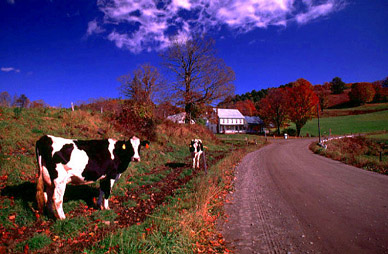In pristine northern Vermont, tucked in the woods, David and Mary Lahar have lived off the electricity grid since moving to their new home in Strafford in 1984. As David reports, concern for the environment and interest in alternative energy technologies were the underlying forces behind their home-building decision. The Lahars obtain between 75 and 80 percent of their electricity from wind, with the rest coming from solar panels.

A Farm near Strafford VT
They use wood for heating and use propane for instantaneous hot water, as a back-up heating source, and for cooking. The Lahars keep their electric needs modest, but recently David has considered putting up a larger wind turbine to provide for his family’s growing needs.
When choosing a lot for the 1,700-foot timber-constructed home, wind was a primary consideration. The Lahars conducted wind tests for a month before they made a final decision. An average of 8 mile per hour (mph) winds are enough to get the turbine paddles moving, and the site they finally chose for their wind turbine on Mount Mansfield has regular 10 mph winds. They constructed a 100-foot platform to raise the windmill above the tree line in an attempt to further capture the wind and installed a Sencenbaugh 1.2 kilowatt wind turbine with 13-foot blades.
In addition to wind energy, the Lahars own four photovoltaic panels, use energy-efficient appliances and lighting, employ passive solar heating, and use a horizontal access washer. Their home is super-insulated with at least 6″ of insulation all around. They burn approximately three cords of wood a year; a modest amount for a 1,700 square-foot home. The energy provided by the wind and sun is able to provide electricity for a small garage and shop as well as the house.
David feels that wind is an under-used resource. He cites Lowell Mountain and East Mountain in Vermont as two potential wind farm sites. He favors greater subsidies for sustainable energy use, because, he argues, this would lessen our dependence on nuclear energy, fossil fuels, and other non-renewable resources, all of whose social costs are significantly higher than the price paid for the commodity.

2 Responses
I’ve been running a wind turbine for years, and not a single dead bird. When one plants a wind farm in a migratory path, one should expect issues. It’s not the wind turbines at fault, it’s the site planners. The news media doesn’t understand the difference, and blames the wind turbine.
Wind turbines are nice, but about the dead bird count?